Introduction
Introduction
The purpose of this study was to better understand the trapping and sealing mechanism of the Jubilee field by benchmarking it against applicable global analogues through the DAKS™ Analogue Solution Workflow. Benchmarking using analogue intelligence is an efficient tool to increase decision quality and to reduce uncertainty in reservoir characteristics.
The Jubilee field was a very prominent discovery made by Kosmos Energy in 2007 and came onstream in 2010. Its’ discovery triggered a shift in exploration efforts towards deep water stratigraphic plays along the conjugate margins of the South Atlantic Ocean (Figure 1). The Mahogany reservoir was deposited in slope turbidite channels and lobes during the Turonian and contains a large hydrocarbon column height of over 1700 ft.
The large hydrocarbon column height in Jubilee indicates that the reservoir must have an effective sealing and trapping mechanism to hold this column. Seal capacity is an important success factor in exploration and is reported as the main cause of dry holes (Castillo et al., 2000; Hall at al., 1997; Houston Geological Society, 2000, 2003; de Ruig et al., 2000; Rudolph and Goulding, 2017). Trap/seal failures are attributed to more than half of dry holes. They are more common than failures of other critical elements of petroleum systems, such as poor reservoir quality, lack of trap or closure, or lack of charge. Therefore, calibrating trap/seal uncertainties is critical for exploration success.
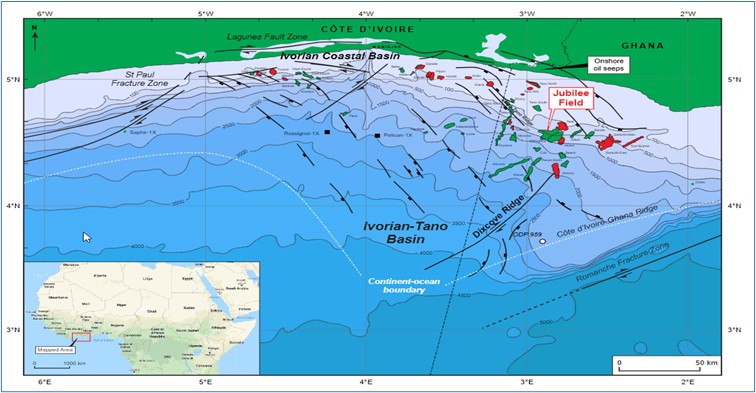
Figure 1 – Location of the Jubilee field (Scarselli et al., 2018)
In order to better understand the trapping and sealing mechanisms of the Jubilee Field, the DAKS™ Analogue Solution Workflow (Figure 2) has been used.
DAKS Analogue Solution Workflow has been developed over the past 25 years as a result of multiple global analogue projects completed by C&C Reservoirs and our clients. This workflow is applicable at all stages of exploration and production and is designed to be utilised by geoscientists, reservoir and production engineers, portfolio managers and decision makers (Sun et al., 2020). It has been proven to be efficient in expanding experiences of technical teams and enhancing knowledge on clients’ proprietary assets.
The workflow includes the following steps:
Define the Problems and Objectives:
- Be clear about the specific problems to address and the critical questions to be answered.
Consistently Document Knowledge:
- Catalogue your prospects and assets using a consistent and holistic classification scheme within DAKS.
Choose Relevant Analogues:
- Focus on addressing issues that are critical to an impending decision rather than trying to find exact “lookalike” analogues to your assets or analogues that are geographically close.
Benchmark Targets or Characterise Analogues:
- This should be done in the context of the probabilistic parameter range of the chosen analogues, identifying critical issues and value creation opportunities.
Identify Best Practices:
- This will be achieved through the analysis of specific geological, engineering and production parameters relevant to the critical issues and identifying potential solutions from best-in-class analogues.
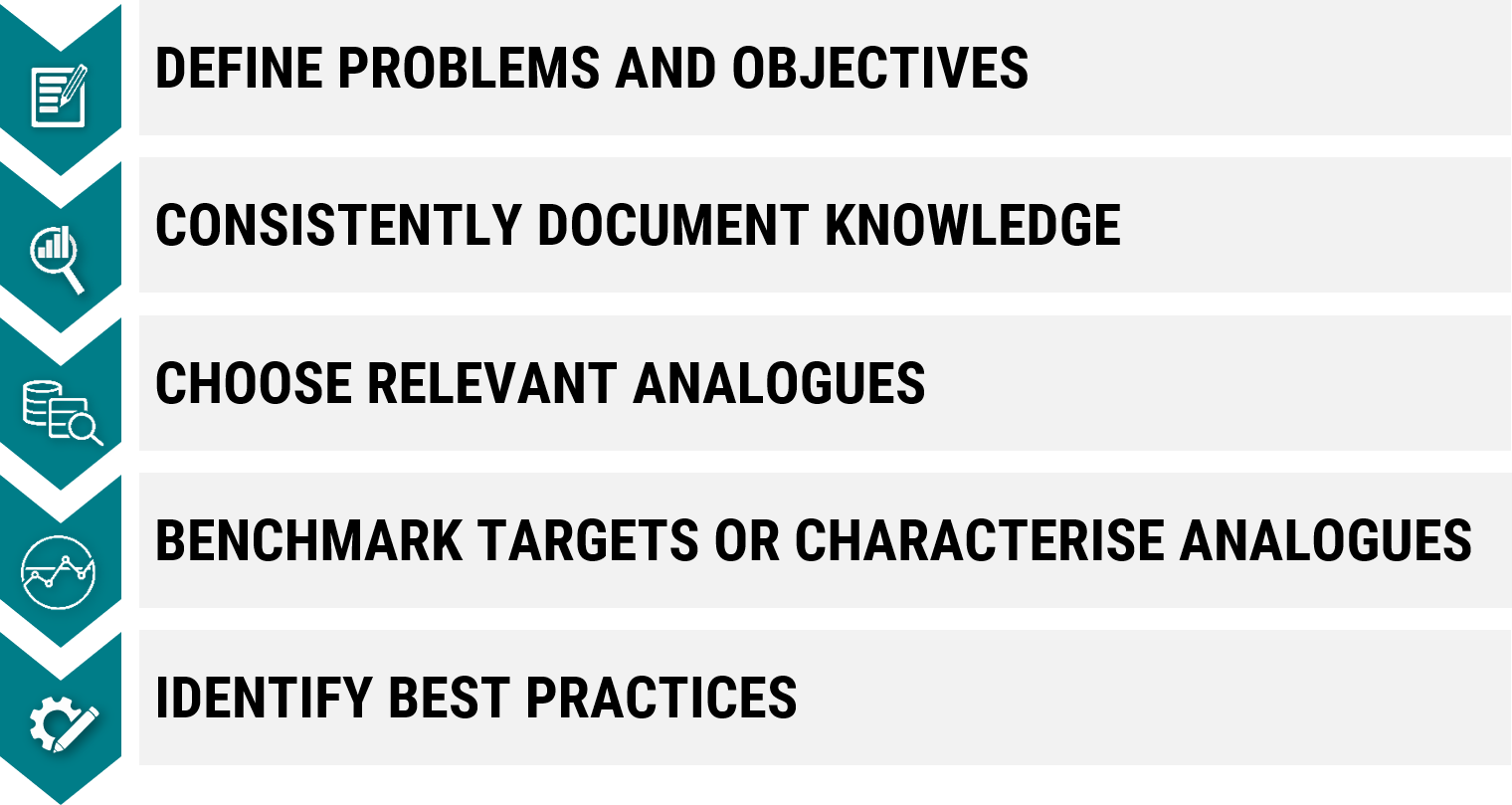
Defining Problems and Objectives
Defining Problems and Objectives
Key questions that will be answered for the Jubilee field in this study are:
- Is Jubilee a direct analogue for stratigraphic traps on passive margins?
- How critical are the up-dip faults in holding a large hydrocarbon column height?
The problem will be separated into two hypotheses. The first hypothesis will test Jubilee as a pure stratigraphic trap (or a Pinch-out trap according to C&C Reservoirs’ internal classification system), and the second hypothesis will test it as a pure normal fault trap. These two end member solutions will be evaluated and benchmarked against applicable sets of analogues.
Consistently Document Knowledge
Consistently Document Knowledge
Based on public domain information contained in Jubilee’s Field Evaluation Report, both text and numeric parameters have been standardised and classified using the consistent rules of C&C Reservoirs’ comprehensive classification scheme. Knowledge standardisation facilitates a like-for-like comparison and enables knowledge capture in a consistent manner when using DAKS™.
Choose Relevant Analogues
Choose Relevant Analogues
Given the objective of this study, the following selection criteria were used to identify appropriate analogues (Table 1).

Table 1 – Analogue search matrix for the Jubilee Field.
Characterise Analogues
Characterise Analogues
DAKS™ Classification
DAKS™ Classification
The synthesised and systematically classified knowledge on proven fields in DAKS helps calibrate prospect uncertainty range and deliver a higher degree of confidence in prospect evaluation through benchmarking. Key learnings in proven producing fields can be transferred both within and between basins to test ideas and initial interpretations. Figure 3 and 4 show the elements of the C&C Reservoirs’ Trapping Mechanism Classification used to test both hypotheses.

Figure 3 – C&C Reservoirs’ Trapping Mechanism Classification for lateral depositional change analogues (Screenshot from DAKS™)
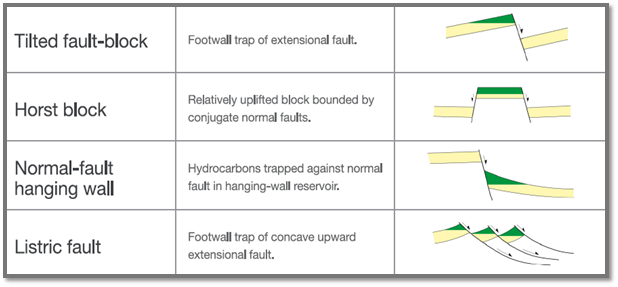
Figure 4 – C&C Reservoirs’ Trapping Mechanism Classification for normal fault analogues (Screenshot from DAKS™)
How does Jubilee compare to pure Lateral Depositional Trap analogues?
How does Jubilee compare to pure Lateral Depositional Trap analogues?
To test the first hypothesis, Jubilee was benchmarked against analogous traps that were formed in a rift/passive margin trap tectonic setting and have a lateral depositional change trapping mechanism. Trap flank dip, productive area and total hydrocarbon column height are the selected parameters to evaluate trapping and sealing capacity.
Generally, there is a lot of uncertainty associated with these when prospecting. Therefore, subsurface geological analogues of proven reservoirs provide objective intelligence to test the validity of play concepts. This can quickly be gained by analysing the probabilistic distribution of analogue knowledge to help establish the range of possibilities (Table 2).

Table 2 – Probabilistic distribution of P90-P10 range of lateral depositional change analogues for the key numeric parameters. (Screenshot from DAKS™ Characterisation tool).
The histogram for trap flank dip in degrees indicates a range from 1° to 12°, with a geometric mean of 3.6°. More importantly, the 5° dip on the Jubilee field falls on the higher side of the distribution, well above the P50 and Mean values. Stratigraphic trapping mechanisms are often subtle structures and Jubilee is quite steep when compared to global analogues. Therefore, benchmarking indicates that Jubilee is less likely to be considered a pure lateral depositional change trap based on the steep dip configuration (Figure 5).
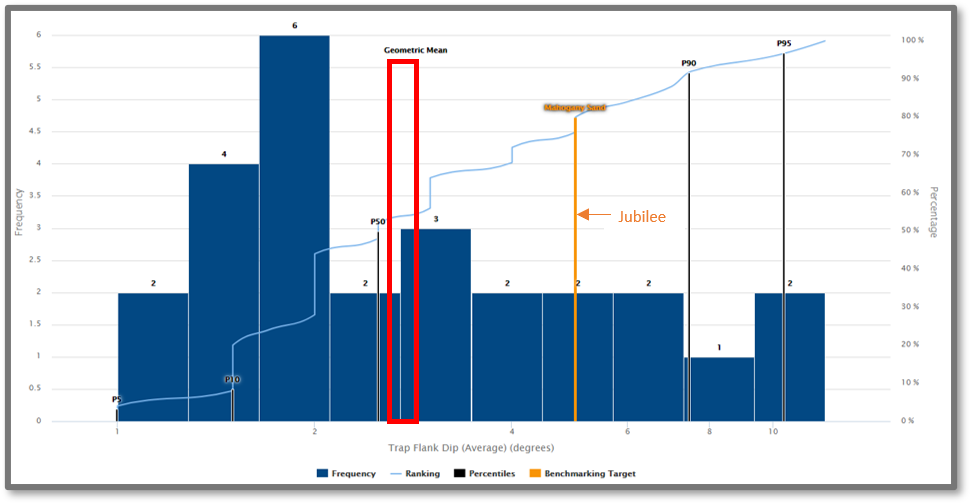
Figure 5 – Global analogues indicate the range of Trap Flank Dip for lateral depositional change traps in rift and passive margin trap tectonic settings (Screenshot from DAKS™ Characterisation tool)
The histogram for total hydrocarbon column height indicates that Jubilee ranks very high when compared to global lateral depositional change analogues. Jubilee’s column height is above the P90 value showing that 92% of the samples’ total column heights are lower than Jubilee’s. Therefore, it is very unlikely that such a large hydrocarbon column height can be supported purely by a lateral depositional change trapping mechanism (Figure 6).
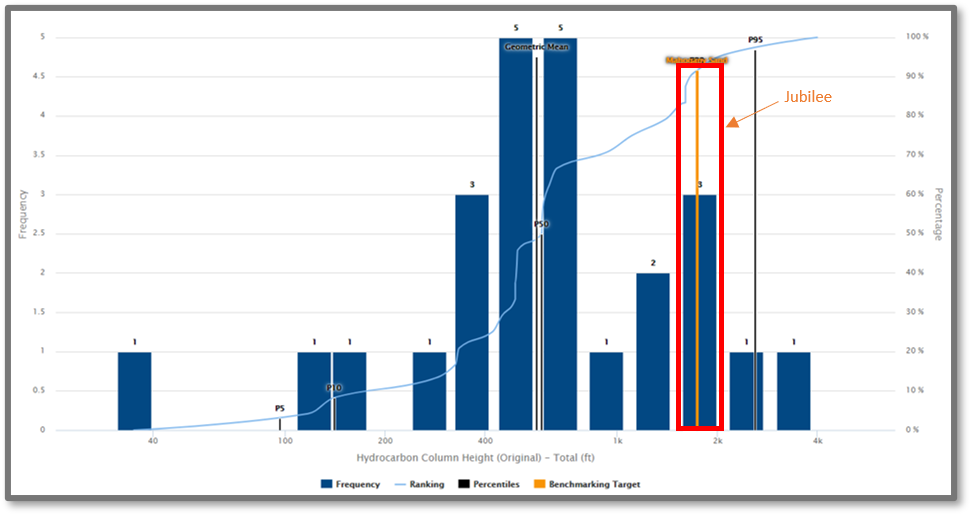
Figure 6 – Global analogues indicate the range of Total Hydrocarbon Column Height for lateral depositional change traps in rift and passive margin trap tectonic settings (Screenshot from DAKS™ Characterisation tool)
Jubilee has the largest total hydrocarbon column height in analogues with dips greater than 4°. In addition, Mars field, a proven pure stratigraphic trap with a significantly large total hydrocarbon column height is even smaller than Jubilee’s. This demonstrates that it is very unlikely that Jubilee’s massive hydrocarbon column height can be supported by only a pure high dip lateral depositional change trapping configuration (Figure 7).
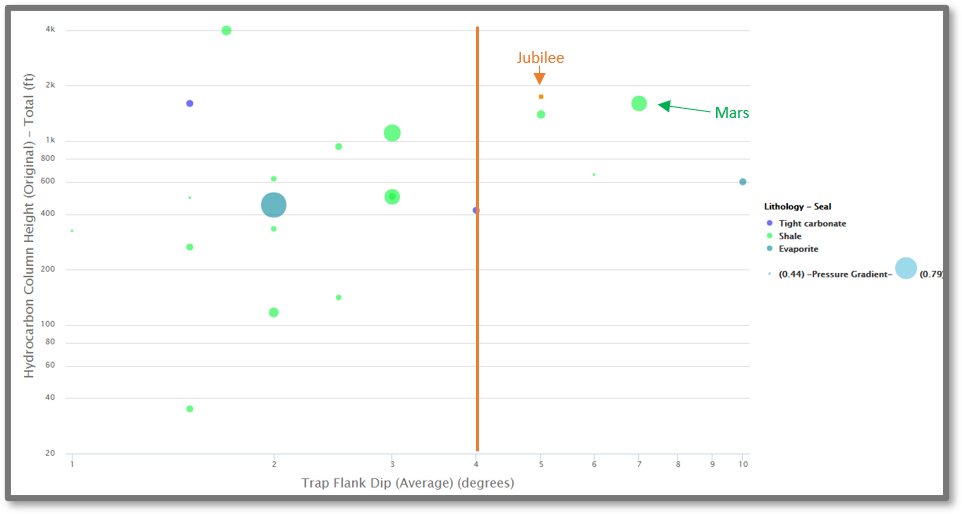
Figure 7 – Trap Flank Dip (Average) (degrees) vs. Hydrocarbon Column Height (Original) – Total (ft) for lateral depositional change traps in rift and passive margin trap tectonic settings (Screenshot from DAKS™ Crossplot tool).
Another relationship analysed is trap flank dip versus productive area. This relationship can help determine if a high dip lateral depositional change trapping configuration can support the high productive area observed in Table 2. The highlighted orange line indicates the maximum productive area limit for a given trap flank dip. As observed, Jubilee field is slightly above the maximum productive area for fields with 5° or above. This demonstrates that Jubilee is a very extreme case when compared to lateral depositional change global analogues. In addition, there are no proven lateral depositional change global analogues that can justify such a large productive area with a high dip configuration to be considered a pure lateral depositional change trap (Figure 8).
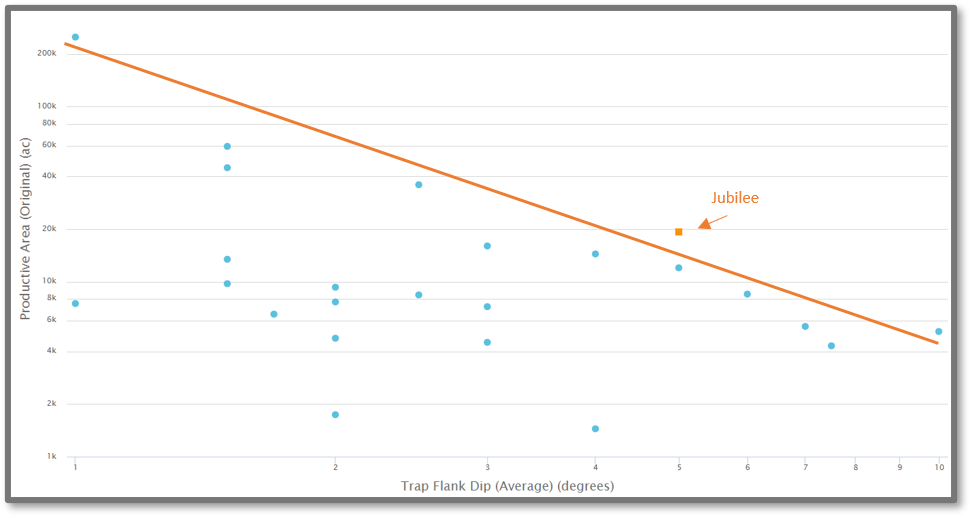
Figure 8 – Trap Flank Dip (Average) (degrees) vs. Productive Area (Original) (ac) for lateral depositional change traps in rift and passive margin trap tectonic settings (Screenshot from DAKS™ Crossplot tool).
To summarise the first hypothesis, benchmarking against global analogues indicated that it is very unlikely that Jubilee can be classified as a pure lateral depositional change trap based on the steep dip configuration and very large hydrocarbon column height against this sample. More importantly, there are no proven lateral depositional change global analogues that can justify such a large productive area in a high dip configuration.
How does Jubilee compare to pure Normal Fault analogues?
How does Jubilee compare to pure Normal Fault analogues?
To test the second hypothesis, Jubilee has been benchmarked against analogous traps that were formed in a rift/passive margin trap tectonic setting and have a normal fault trapping mechanism. The same set of parameters that were analysed for first hypothesis have been used to calibrate uncertainty during this stage (Table 3).

Table 3 – Probabilistic distribution of P10-P90 range of normal fault analogues for the key numeric parameters. (Screenshot from DAKS™ Characterisation tool)
For normal fault traps, the analogues indicate that the trap flank dip range is much wider than for lateral depositional change traps, ranging from 0.5° to 35°. In this set of analogues, Jubilee is ranked below P50 and close to the center of the distribution. Therefore, benchmarking indicates that Jubilee’s trap flank dip is common for normal fault traps based on the dip configuration (Figure 9).
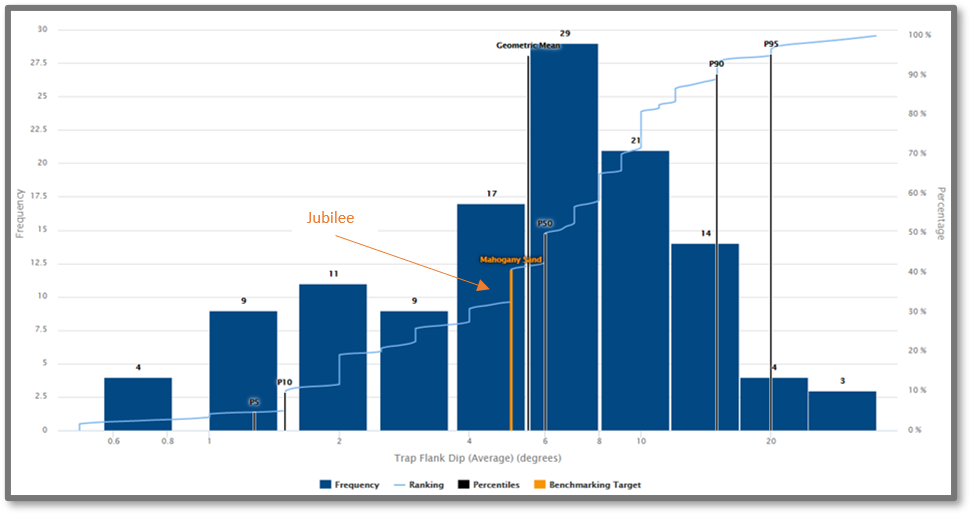
Figure 9 – Global analogues indicate the range of Trap Flank Dip for normal fault traps in rift and passive margin trap tectonic settings (Screenshot from DAKS™ Characterisation tool).
The total hydrocarbon column height histogram indicates that Jubilee still falls on the high end of the distribution. This was also observed when testing the first hypothesis against lateral depositional change trapping mechanisms. This is significant because the initial interpretation for total hydrocarbon column height appears to be very optimistic even when compared against normal faults that are generally larger than lateral depositional change traps. Therefore, a combination trapping configuration might be an alternative model to justify a very large total hydrocarbon column height (Figure 10).
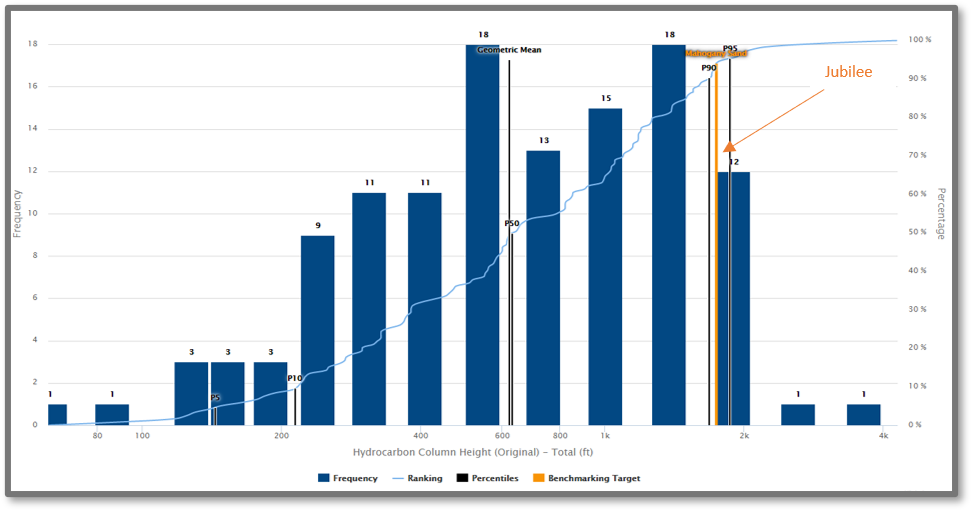
Figure 10 – Global analogues indicate the range of Total Hydrocarbon Column Height for normal fault traps in rift and passive margin trap tectonic settings (Screenshot from DAKS™ Characterisation tool).
Benchmarking of the Jubilee field against normal fault trap analogues is very different from lateral depositional change trapping mechanisms. In this case, Jubilee falls on the higher side of the data set, but still well within the distribution of faulted analogues. Therefore, it is possible to prove Jubilee as a normal fault as it falls within the range of possibilities against this set of analogues. For fields with trap flank dip of 4° or above, multiple examples are observed with proven hydrocarbon column heights higher than the reported for the Jubilee field. More importantly, the overall distribution shows that column height and reservoir dip increase proportionally, as expected for fault traps (Figure 11).
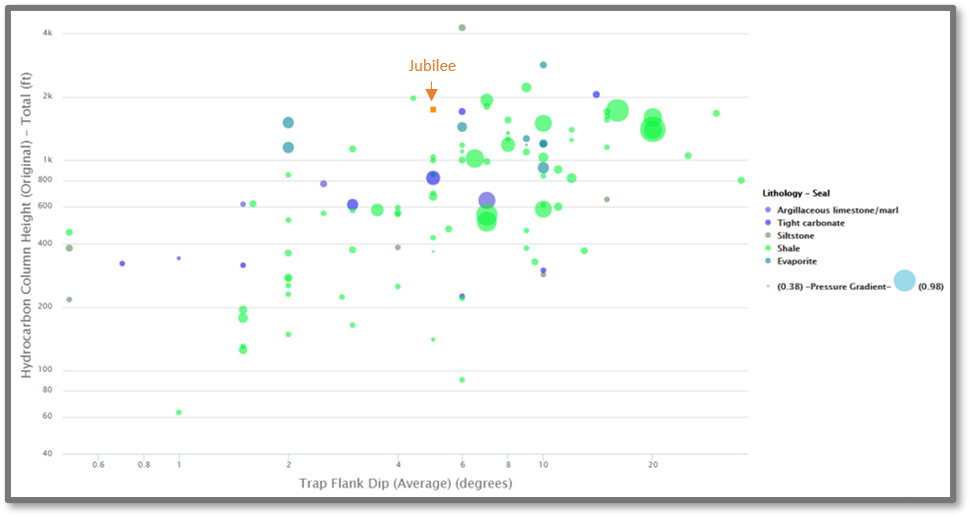
Figure 11 – Trap Flank Dip (Average) (degrees) vs. hydrocarbon column height (Original) (ft) for normal fault traps in rift and passive margin trap tectonic settings (Screenshot from DAKS™ Crossplot tool).
On the trap flank dip versus productive area crossplot, Jubilee also falls within the range of values. Productive area is relatively high, but significantly below the maximum values observed for this type of trapping mechanism (Figure 12).
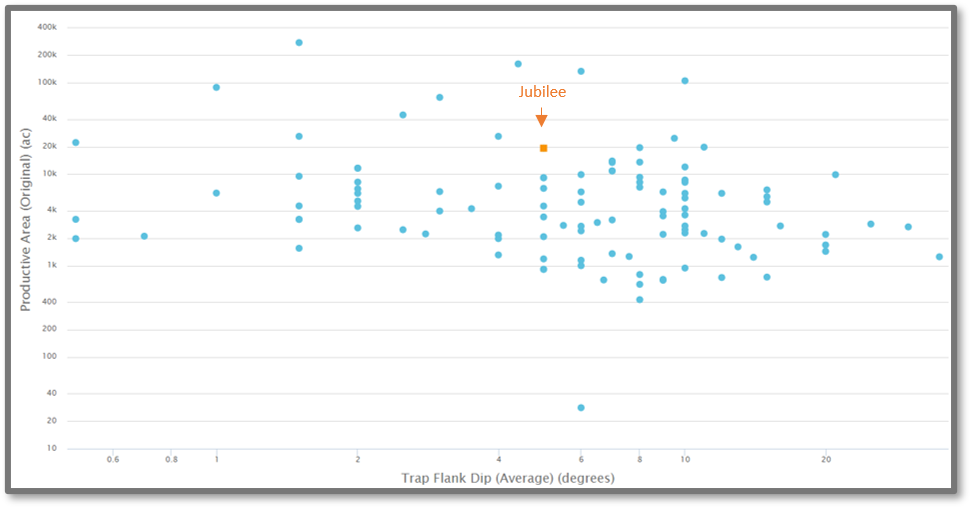
Figure 12 – Trap Flank Dip (Average) (degrees) vs. Productive Area (Original) (ac) for normal fault traps in rift and passive margin trap tectonic settings (Screenshot from DAKS™ Crossplot tool)
To summarise, benchmarking for the second hypothesis, hydrocarbon column height value is ranked high at 94%. However, for fields with flank dip above 4°, both hydrocarbon column height and productive area are well within the analogues distribution and were not identified as extreme values. Therefore, benchmarking indicates that Jubilee correlates well with this type of trapping mechanism.
Conclusion
Conclusion
For the trap flank dip, the Jubilee field falls on the high end of distribution among pinch-out traps. A very high hydrocarbon column height is observed when testing both end-member hypotheses. Jubilee has the largest total hydrocarbon column height among lateral depositional change traps with flank dip of 4° or above. In addition, the relationship between productive area and flank dip was examined. In this case, Jubilee exceeds the maximum productive area among lateral depositional change traps while it fits well within the distribution of normal fault trap analogues.
Benchmarking against pure lateral depositional change and pure normal fault traps shows that the Jubilee field represents a high-end example of stratigraphic traps; and that Jubilee’s hydrocarbon column height can be supported by a normal fault trap.
Based on the analysis conducted through the solution workflow, the following conclusions have been made:
- Benchmarking of the Jubilee field against global analogues indicates that the up-dip normal fault trap is a critical contributor to effectively sealing the field.
- Jubilee field appears to be a combination of stratigraphic and fault traps, sealed up-dip by faulting and laterally by sand pinch-out.
Understanding trap/seal integrity is an important success factor in exploration. In this case study, the analogue solution workflow was used to benchmark and validate trapping and seal interpretation for the Jubilee field.
An example has been shown how trap and seal analogues may be selected and analysed in DAKS™. Multiple additional parameters can be used to analyse the effectiveness of traps and seals, such as seal depositional system, lithology, thickness, reservoir lithology and properties, pressure gradient, hydrocarbon fluid properties and others which are a part of DAKS™ internal classification system. Analogue Solution Workflow was demonstrated to be a viable tool to benchmark reservoir characteristics and reduce uncertainty ranges.
References
References
Castillo, D. A., Bishop, D.J., Donaldson, I., Keuk, D., De Ruig, M., Trupp, M., and Shuster, M.W., 200, Trap integrity of the Laminaria High-Nancar Trough region, Timor Sea: Prediction of fault seal failure using well constrained stress tensors and fault surfaces interpreted from 3D seismic, APPEA Journal, no. 40(1), p. 151-73.
Daily, P., Henderson, T., Hudgens, E., Kanschat, K., and Lowry, P., 2013, Exploration for Cretaceous stratigraphic traps in the Gulf of Guinea, West Africa and the discovery of the Jubilee Field: a play opening discovery in the Tano Basin, Offshore Ghana, in Mohriak, W.U., Danforth, A., Post, P.J., Brown, D.E., Tari, G.C., Nemcok, M., and Sinha, S.T., eds., Conjugate Divergent Margins: Geological Society, London, Special publications, no. 369, 15 p.
De Ruig, M.J., Trupp, M., Bishop, D.J., Kuek, D. and Castillo, D.A., 2000, Fault architecture in the Nancar Trough/Laminaria Area of the Timor Sea, Northern Australia, APPEA Journal, no. 40(1), p. 174-93.
Rudolph, K.W., and Goulding, F.J., 2017, Benchmarking exploration predictions and performance using 20+ yr of drilling results: One company’s experience, AAPG Bulletin, no.101(2), p. 161-176.
Scarselli, N., Duval, G., Martin, J., McClay, K., Toothill, S., 2018, Insights into the early evolution of the Côte d’Ivoire Margin (West Africa), in McClay, K, R., and Hammerstein, J. A., eds., Passive Margins: Tectonics, Sedimentation and Magmatism: The Geological Society, London, Special Publications, no. 476, 25 p.
Sills, S., and Agyapong, D., 2012, Jubilee field reservoir description and waterflood performance overview: Offshore Technology Conference, Houston, OTC 23451, 15 p.
Sun, S.Q., Pollitt, D., Wu, S.Y., and Leary, D., 2020, Use of global analogues to improve E&P decision quality: AAPG Bulletin in press.
